Refusal of Care: Disabled Women and Breast Cancer Screening
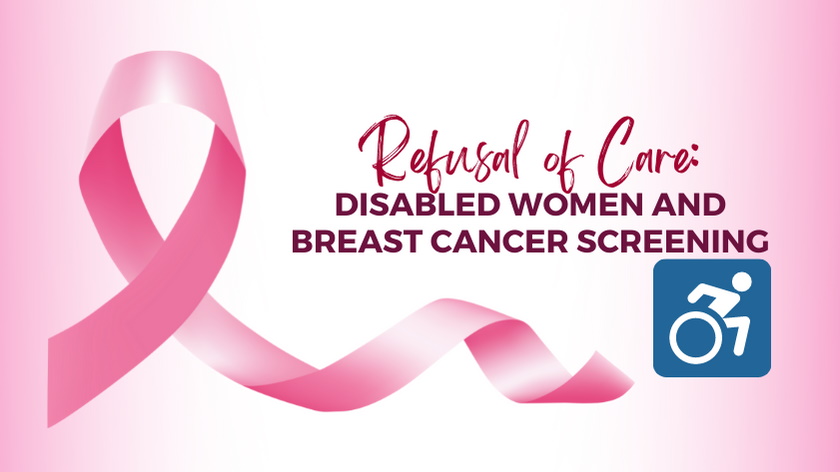
Updated March 16, 2022
I was long past the recommended age to have a mammogram the first time I had one. The reason? Lack of accessibility in cancer screening equipment and procedures. And I’m not alone. Breast cancer is the most frequent type of cancer among women, yet women who have a disability are less likely to have obtained a mammogram.
I had rheumatoid arthritis (RA) since childhood and growing up in the time before effective treatments, I became disabled in my teens. I can’t stand and have limited mobility in my arms and shoulders. This means I can’t assume the positions required for a mammogram. But given that I’ve had a lump in my breast for several decades, something that should be monitored, we found a workaround.
Instead of a mammogram, I had an ultrasound. I brought an attendant to the appointment would help me transfer onto the gurney and with the help of some foam blocks, I got into the position for the test. But accessibility is not just about physical access. At the time, they used a scented gel, likely to make the experience as pleasant as possible. For me, it wasn’t. It triggered an asthma attack that lasted for days. The next time I showed up for my ultrasound, I asked if they had fragrance-free ultrasound gel. After an exhaustive search in the entire hospital, the answer was no. So I did not have an ultrasound.
When you live with disability and chronic illness the, you learn to be resourceful. A couple of years later, I called to make another appointment, intending to bring my own fragrance-free ultrasound gel. At which point I was told they no longer use ultrasound for screening. I tried to explain my situation and asked for accommodation of my disability but met a brick wall. I asked my family doctor for help and was told she’d try to work the system, which apparently required speaking nicely with them in order to not to alienate the clinic.
Years later, I am still astonished that this was necessary. Surely it should be as easy as saying “my patient has a disability. Find a way to screen her that doesn’t involve a mammogram”? But maybe I’m being unreasonable…
Health discrimination against disabled women
Hospitals are generally fairly accessible, albeit in a rudimentary way (elevators, wider doors, etc.). But this is often not the case in community-based doctors’ offices and clinics. Linda Gauthier from Québec has a disability and when she needed the mammogram, she did what most of us do before we go anywhere: called ahead to check whether the mammogram clinics were accessible. Sixteen clinics refused to give her a mammogram. SIXTEEN!
That is, they told her they did not serve women in wheelchairs either because the clinic was not accessible or the technicians had not been trained in how to lower the mammogram machine. Gauthier fought back, filing a human rights complaint and the story blew up from there. The Québec Minister of Health got involved and has stated that in future, any clinics that are not accessible will not get a permit to perform mammograms.
Women with disabilities often experience health disparity. For instance, in a 2010 study of the barriers preventing women with disabilities from getting screened for breast cancer as often as is recommended, indicated a lack physician recommendation. In other words, doctors don’t talk to women with disabilities about getting screened for breast cancer. This is often also the case for pap tests. Medical professionals may assume that women with disabilities are not sexually active and therefore don’t need Pap tests. In a Canadian study (PDF), women with disabilities reported often only receiving healthcare in the narrow area of what is directly related to their disability, a phenomenon colloquially known as “diagnosis blindness,” in which a chronic or disabling condition becomes the primary focus in someone’s medical care.
Yes, the systemic ableism of the healthcare system is defined by an ableist term. Sigh…
This narrow focus is not a surprise to those of us who live with RA. We actually have what’s called a mortality gap, lower life expectancy for a number of reasons, including lack of adequate primary care (before you hyperventilate, it’s getting much better). When someone has a significant health issue, such as a chronic illness or disability, doctors tend to develop blinders in their approach to treatment.
But it’s not just about that. It’s also about other types of preventative healthcare being affected by the attitudes of medical staff.
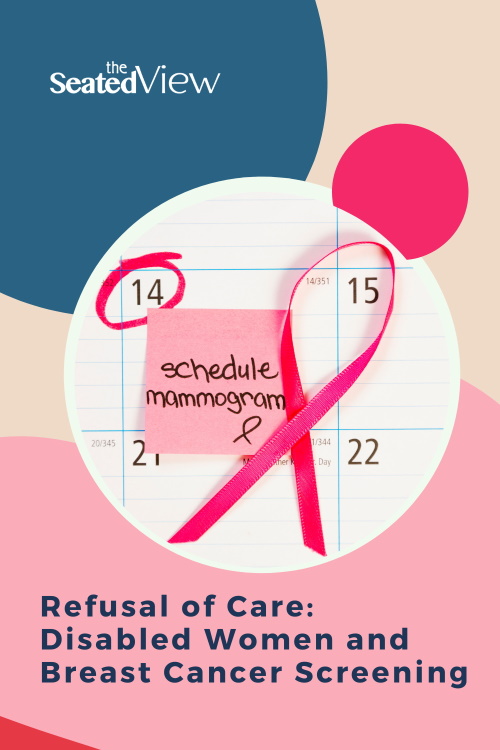
Cultural stereotypes of disabled women
One of the stereotypes that women with disabilities face is the belief that we are asexual creatures. This belief is reflected in the lack of role models for women with disabilities, the lack of disabled women in media, movies and on TV as anything other than a victim or poor unfortunate. It’s reflected in the fact that anyone attracted to a woman with a disability is perceived as either a saint or a pervert (because only perverts are attracted to women in wheelchairs). And it’s reflected in the common question I get about whether The Boy is my brother and the stares when we hold hands in public.
And it is of course not only as sexual beings that we are nonentities. It is in the world in general where we are unrepresented in the workplace, in the media, in politics.
Women with disabilities are invisible. As the medical world exist in and is a product of our society, our social invisibility carries over to become a medical invisibility. When dealing with health care disparity, the focus tends to be on race and ethnicity, with very little mention of disability. Which brings me back to mammograms.
Refusal of care
Not being able (or willing) to accommodate someone with a disability isn’t just discrimination — as if there is anything ‘just’ about that. In a healthcare environment, lack of accommodation of disability equals refusal of care.
And it’s systemic, built into the foundation of healthcare. In 2014, I obtained a copy of a memo from a company that runs a number of diagnostic centres in Ontario (I am not specifying which company, as it may reveal my source). It stated that mammography was the recommended primary screening tests for breast cancer for all women. Furthermore, that it is the only imaging technique licensed by Health Canada for breast cancer screening for the general population. Ultrasound is not recommended (code for “not funded”). Why? According to the memo, studies have shown that ultrasound is not as effective in detecting a variety of cancers and may lead to a high number of false positives. This in turn can lead to an unacceptable high number of biopsies. This can have an impact on patients, but is also expensive in a publicly funded healthcare system.
Fair enough. In general. But not if it leads to a lack of flexibility in the system that can cause a disparity in the delivery of healthcare for certain populations in particular. Women with disabilities may be willing to assume the risk of a false positive test resulting in a biopsy, as it is ultimately achieves the result of screening for cancer more effectively than… well, not being screened at all.
So how did I actually get a mammogram? I made an appointment to talk to the specialist at my local breast clinic and explained the problem. She told me that their mammogram and that they had provided the test for wheelchair users before. At some point in the previous seven years, they had apparently got a new mammogram machine. I brought my partner to the appointment between him and the technician, I got into the right position on the machine that could both be lowered and twisted to accommodate my body. And then the technician squeezed the crap out of my breasts, while my partner held me in place and I was finally screened for breast cancer (PS it was negative).
Removing barriers to healthcare for disabled women
Improving accessibility in cancer screening starts by talking about the fact that the obstacles exist and what not to do. For instance, accommodation does not mean duct taping a disabled woman to a mammogram machine. No, I am not making that up.
Inclusive healthcare includes making equipment adjustable and tests universally accessible and in cases where this is temporarily not possible, providing workarounds and alternatives. Adjustable exam tables must be the norm so women with disabilities can get pap tests. All clinics and diagnostic centres must b e physically accessible so disabled members of the community can access healthcare independently.
Accessible healthcare also includes training medical staff to expect disabled patients and giving them the information they need to adapt their practice and tests. It includes continuing to fund remote doctors’ appointments and, if necessary, home visits as this may easier to perform at Pap test in a disabled person’s home. Drilling down to basics, accessible healthcare means creating procedures and tests that are adaptable to a variety of levels of function, rather than expecting everyone to conform to a particular gated way of performing a test. Bodies are different and they function differently. This fact should not be the basis for exclusion in any medical test or procedure, particularly potentially life-saving ones.
But we should also begin a conversation about the consequences of these barriers and the resulting refusal of care. Consequences that mean people with disabilities may be sicker than they have to be. That may in fact mean that women with disabilities are more likely to die from breast cancer or cervical cancer because they are not accommodated in screening tests and the cancer is therefore discovered later than it should be.
To quote myself, it’s about throwing out the norm and finding another way to your goal. And when you’re talking about cancer screening, this could save lives.

5 Comments
Read More
Discover what else I've been writing about...



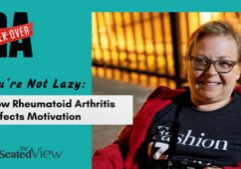






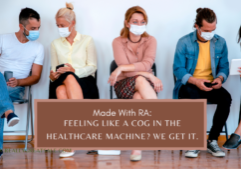



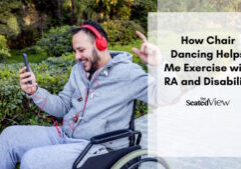


We ought to have a conference, or at least have this as a topic at a conference. You could do a dynamite speech. It's actually so bad that anyone with any chronic disease has to ignore their health problem to get care for another issue. So many doctors say, or their forms say “What is your ONE health issue for today?”
Person centered care? No, that's not what we see.
Did you talk to the Ontario Breast Screening Program too?
Lene my friend must have an ultrasound each time she has a mammogram as she has had breast reduction surgery in the past which has left scar tissue throughout her breasts. Her clinic unfortunately is in Port Perry, which is too far for you to travel unless your doctor recommends it. The clinic is “Port Perry Imaging” right across the street from the hospital. Hope this helps. Gently cyber hugs going out to you. Helen.
I've said that I wouldn't post comments again because I hate BlogSpot's “prove you're not a robot” issues, but this is way too important not to express my outrage. Thank you for giving voice to this intolerable injustice.
I gasped probably loud enough for you to hear clear from there–DUCT TAPED someone?! Holy. Cow.
I know from experience that at Stanford Hospital they will, if need be, wheel a machine to your bedside to do a chest x-ray without the patient having to get up when they're too ill too. So why not a mammogram machine?
Mammograms are painful enough for me and I don't actually have a disability. I can't imagine coming at it with already-damaged shoulders and the inability to stand in a seriously unnatural position. The trend here is “mobile mammography”, where they being a bus to a work site and so exams in the bus. Good luck if you can't walk up the stairs.